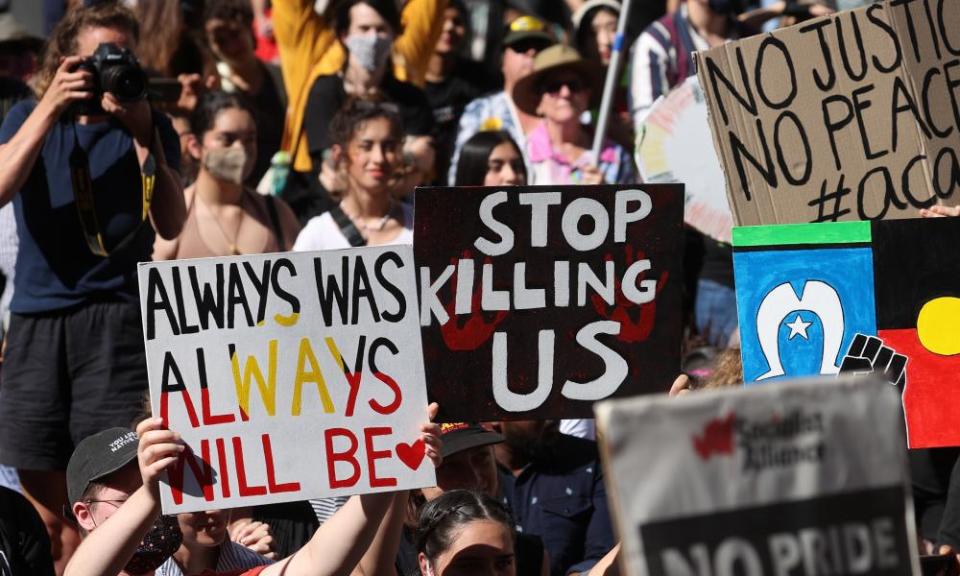‘Beyond heartbreaking’: 500 Indigenous deaths in custody since 1991 royal commission

Aboriginal justice expert says governments continue to ‘stall on urgent action’ to prevent deaths
Five hundred Aboriginal and Torres Strait Islander people have died in custody in Australia in the 30 years since a royal commission handed down a report aimed at preventing Indigenous deaths in the justice system.
The national Aboriginal legal service released the grim toll on Monday, saying it is “beyond heartbreaking”.
The latest Australian Institute of criminology figures show there were 489 Indigenous deaths in custody since the end of the 1991 royal commission to June 30, this year.
Related: Stanley Russell: why did NSW police shoot an Aboriginal man dead in a Sydney house?
Since then, there have been another 11 deaths, including four in the past five weeks, the National Aboriginal and Torres Strait Islander Legal Services (Natsils) says.
In November, 43-year-old Glen Francis was found unresponsive in a cell at Queensland’s Maryborough correctional centre, a 26-year-old Aboriginal man was found dead in Cessnock jail in New South Wales.
Gomeroi man Stanley Russell was shot dead by police at his aunt’s home in north-western Sydney, also in November. In late October, a 27-year-old Indigenous Queensland man died during what authorities described as a “violent struggle” with police.
“To have lost 500 of our people in custody since the royal commission handed down their recommendations over 30 years ago is beyond heartbreaking,” said Jamie McConnachie, executive officer at Natsils.
State and federal governments continued to “stall on urgent action” to prevent deaths in custody, McConnachie said.
Related: The facts about Australia’s rising toll of Indigenous deaths in custody
She said governments have not fully implemented the royal commission’s 339 recommendations, or those of the Australian Law Reform Commission’s Pathways to Justice inquiry, the Don Dale royal commission and many coronial investigations.
“Our people continue, and will continue, to die from failures to implement these crucial recommendations,” McConnachie said.
“All the while, the burden shifts to grieving family members to push for the change needed to prevent more deaths in custody. The onus and burden of pushing for implementation should be on governments, not families.”
The federal government relies on figures provided by the Australian Institute of Criminology (AIC) to track custodial deaths. In May this year the AIC said it would speed up its reporting on Aboriginal deaths in custody, after sustained criticism that it was taking too long to produce data that could drive policy reform.
The lack of reliable statistics was a recurring theme of the 1991 royal commission into Aboriginal deaths in custody. Recommendation 41 called for the states and territories to maintain a statistical database tracking all deaths in custody and report annually to parliament. The AIC’s national deaths in custody program was established in 1992 to fulfil this role but until recently only reported every few years.
Related: ‘I want to break that cycle’: the relatives still fighting for justice over deaths in custody
In 2018, Guardian Australia created the Deaths Inside database to track all known Aboriginal deaths in custody, because real-time information had been so hard to find. The Guardian last updated it in April on the 30th anniversary of the royal commission. Since that update, at least 11 more Aboriginal people have died.
In 1991, the royal commission concluded that Indigenous people were no more likely to die in custody than non-Indigenous people, but were significantly more likely to be arrested and imprisoned.
“The same remains true today,” an AIC report says.
Aboriginal and Torres Strait Islander people comprise 3% of the Australian population but make up 30% of the prisoner population. Based on current data, they are six times more likely to die in custody than non-Indigenous people.

 Yahoo Finance
Yahoo Finance 